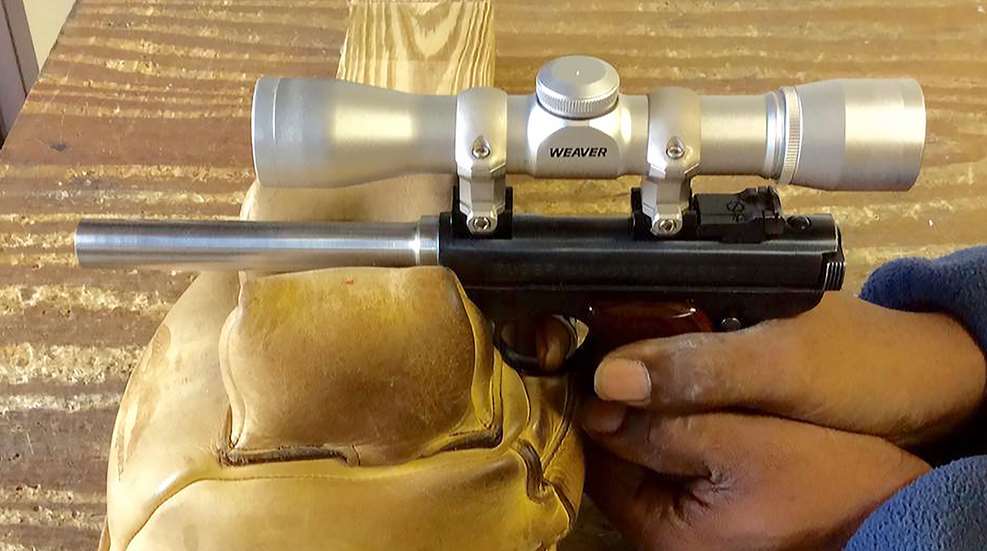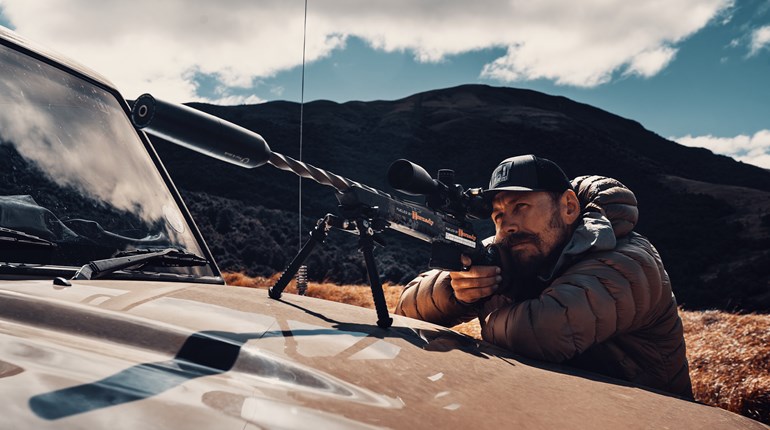
WARNING: All technical data in this publication, especially for handloading, reflect the limited experience of individuals using specific tools, products, equipment and components under specific conditions and circumstances not necessarily reported in the article and over which the National Rifle Association (NRA) has no control. The data has not otherwise been tested or verified by the NRA. The NRA, its agents, officers and employees accept no responsibility for the results obtained by persons using such data and disclaim all liability for any consequential injuries or damages.
Above: Whether testing a rifle or pistol, with optics or irons, some elements—such as good, consistent benchrest technique—will remain constant.
In this article we’ll discuss the specialized aspects of using iron sights for accuracy testing our ammunition. Our previous article addressed optical sight accuracy testing. It may be useful to those who missed them to read Part 1, Part 2, Part 3 and Part 4 of this series.
Accuracy Testing: Iron Sights
For various reasons, a competitor might elect to test his rifle/ammunition’s accuracy with iron sights instead of optics. By “iron sights,” of course we mean aperture rear sights, not the barrel-mounted sporting, buckhorn, etc. sights found on hunting rifles.
While these can get the job done in hunting, they are vastly inferior to a quality peep sight for precision shooting. Some rifles may be difficult and/or expensive to scope, such as a NM M1A (relative to, say, a NM AR-15.) Even when scoped, some rifles require such high or awkward head positions that shooting them extremely well becomes a challenge.
On the other hand, a good number of die-hard Service and Match Rifle shooters don’t practice or test much with optics or from a shooting bench. That is an acquired skill in itself, as we outlined in the several previous chapters. Thus, they may be very comfortable testing with iron sights—whether from the bench or prone with a sling.
It’s important to realize that when choosing to test with iron sights, certain complexities will be introduced that were not present with a scope. Moreover, one advantage of the telescopic sight is lost—magnification, and with it, finer resolution and the ability to see rifle unsteadiness on target and eliminate it.
Nuances of Testing with Iron Sights
In previous chapters we detailed methods to remove parallax effect on our accuracy with a scope at our given target distance. Iron sights require a very consistent head position on the rifle stock, much like a scope that’s not properly adjusted parallax-free.
Changing head height, angle, cheek pressure on the stock, eye relief, etc. from shot to shot can introduce inconsistencies that increase our group size. For this reason, it’s good to avoid any actions that cause a shooter to unnecessarily break his position during a string of shots, such as reloading when not required, roughly working a bolt-handle and disturbing the position excessively, etc.
When shooting with a scope, one is primarily concerned with sight *picture*—i.e., where the crosshairs are placed on the target. One works to maintain that point of aim precisely without disturbance due to breaking the shot. With iron sights, one now introduces a new element: sight *alignment*. This refers to the precision placement of the front sight in relation to the rear sight, be it a post front sight in the center of an aperture rear sight, or aperture front and rear sights.
Sight picture is still important, but sight alignment is critical. With perfectly aligned sights, the sight picture can be off a surprising amount and the shooter can still get a “10” or “X”, depending on target size and discipline. With a perfect sight picture but imperfect sight alignment, the shot is likely to stray far afield.
Thus, one must balance these two functions while shooting and ensure sight alignment is excellent-to-perfect for every shot. This requires changing the eyes’ focus—from aligned sights/target (sight picture) to aligned sights with focus on the front sight (sight alignment. This is because the eye can only focus precisely on 1 thing at a time. That one thing needs to be the front sight when the shot breaks, for best results.
Eye fatigue is another variable which becomes more important during iron-sight testing. The eye can only maintain precision focus for a limited period. One must be careful not to exceed the eye’s capability, or poor shots will result. Resting the eyes between groups or even shots—changing the focal distance, looking at a green, wooded area, etc. can help one get optimal performance.
Matching Targets with Sights
As we detailed previously, it’s very important to match one’s target type/size to one’s iron sights. The author has seen countless people attempting to shoot at orange, 1” or 2” squares/circles at 100 yards with battle rifle or hunting sights that are much larger than the target. This virtually guarantees frustration.
In the author’s view, anything that draws the shooter’s attention *away* from sight alignment, and *towards* sight picture introduces the risk of inaccuracy. A tiny target perched in the exact center of a very wide front sight blade makes the shooter work to keep that target precisely on the centerline of the front sight. As the eye can focus on only one thing at a time, this naturally draws effort/attention away from sight alignment and error can creep in.
Choose a large, distinct (i.e., black, heavily contrasting) target so that one need not be overly concerned with sight picture once it’s been correctly obtained. This lets the shooter attend more to sight alignment, which is critical.
This concludes Part 5 in our series on accuracy testing and chronographing. In our next article, we’ll further explore aspects of precision testing using iron sights, such as point of aim (center hold, six o’clock, line-of-white), optimal dimensions for sights, effects of light on testing, shooting from position vs. benchrest, and statistics, among others.
SSUSA thanks the U.S. Army Marksmanship Unit for allowing the reprint of this article.

































